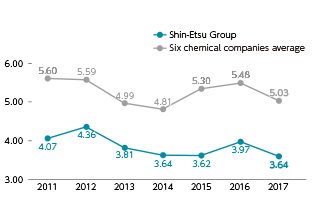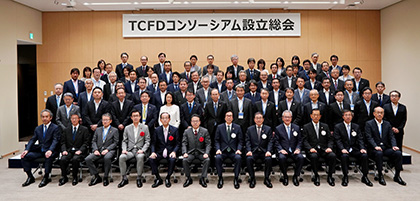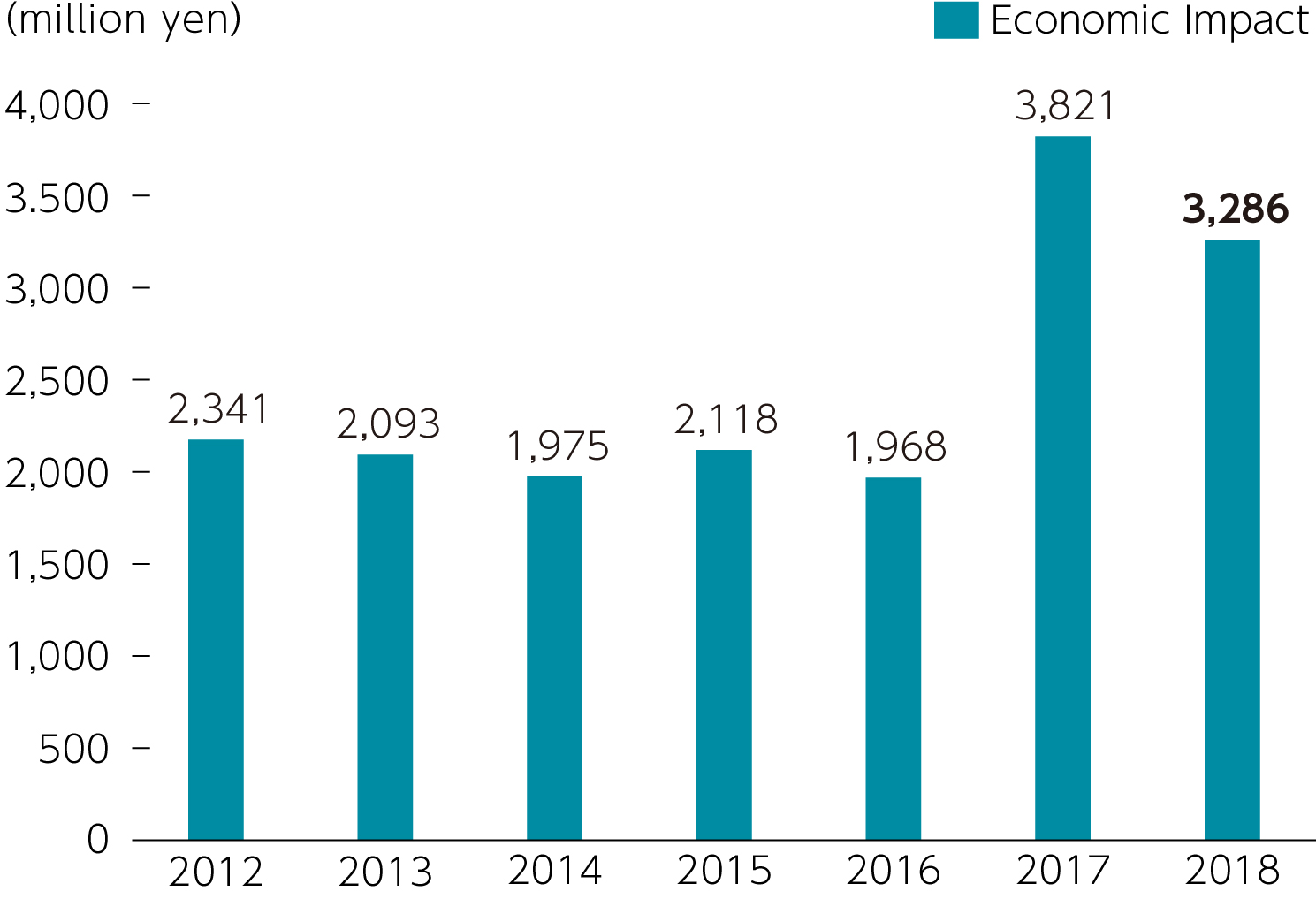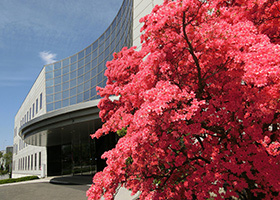CSR Report of the past
Shin-Etsu Group Key CSR Issues
Key Issue2: Energy-saving, resource-saving and the reduction of the environmental impact
Policy
The Group will meet various environmental challenges for the future of the earth.
- Environment Management
- Response to climate change
- Water resource conservation, water pollutant elimination
- Waste reduction
- Resource recycling
- Conservation of biodiversity initiatives, pollutant countermeasures
- Environmental Accounting
Environment Management
Environment Management System
The Group works on Energy savings, waste and chemical substance management. We annually create the Shin-Etsu Group Environmental Safety Management Plan in accordance with the Responsible Care Codes1 and set goals using numerical numbers. The Company and all the Group companies set goals annually according to this plan and work on their activities. Annual activity results are reported to the director in charge of the environment control at the Group Environmental Protection Conference.
In order to increase the level of activity, each plant and the Group companies perform several internal audits a year to check if their goals are appropriately set and the progress they have achieved. In addition, we check the activities and achievements plants have made also through periodical environmental control and safety audits. The results of audits are reported to top management.
Promoting the Reduction of Environmental Impact
The Group constantly works so that manufacturing products will have the least influence on the environment. Furthermore, we do examinations so that our products will have the least environmental influence, which is also energy saving as well as resource saving. Research, Manufacturing and Sales divisions are united to develop such products. These well-examined products are used in various fields including manufacturing industry, our daily lives as well as renewable energy industry.
Reducing the Environmental Impact of Business Activities

- 1 Responsible Care Codes
Six principle areas are addressed when implementing Responsible Care: environmental preservation, process safety (and disaster prevention), occupational health and safety, distribution safety, chemical and product safety, and social dialogue (with the public). The codes initiatives in these areas, together with the Management System Codes required for operating all the above. - 2 PRTR controlled substances
462 substances designated as Class I designated chemical substances from the "Pollutant Release and Transfer Register in the Act on Confirmation, etc. of Release Amounts of Specific Chemical Substances in the Environment and Promotion of Improvements to the Management." - * In order to clearly define the power consumption reduction efforts, the average power-CO2 conversion factor from 2000 to2009 is used.
- * Waste standards and PRTR controlled substances differs from country to country, the figures for the Company and Group companies in Japan were counted.
- * Waste recycling ratio indicates the ratio of an amount recycled to total waste generated.
- * Final disposal ratio indicates the ratio of an amount of landfill waste to total waste generated.
Targets and Results
The following are Targets and Results for environmental protection and chemical substance management for FY2018 as well as Targets for FY2019.
Environmental Certification
In 1996, Shin-Etsu Chemical's Gunma Complex obtained ISO 14001 certification, becoming the first facility of a major chemical company in Japan to achieve such certification. The Group has continued to obtain ISO 14001 certification, the international standard for environmental management systems.
Response to Climate Change
| Mid-term target | Reduce the greenhouse gas emissions in production intensity to 45% of the 1990 level by 2025. |
|---|---|
| Results and evaluation in FY2018 | The Shin-Etsu Group was at 52.8%, and Shin-Etsu Chemical was at 47.9%. |
| FY2018 target | Reduce energy consumption in production intensity at an annualized rate of 1% |
|---|---|
| FY2018 results | The annualized reduction rate from FY2015 to FY2018 was 3.7% for Shin-Etsu Chemical and 2.2% for Shin-Etsu Group. |
| FY2018 evaluation | Both the Group and the Company achieved the target. |
| FY2019 target | Reduce energy consumption in production intensity at an annualized rate of 1% |
The Group regards the global climate change as a critical issue to be resolved, and the ESG Promotion Committee, chaired by the President, comprehensively covers climate change issues. Starting from FY2010, the Group promoted energy savings and installation of a cogeneration system in order to achieve the mid-term goal which is "Reduce the greenhouse gas emission in production intensity to 50% of the 1990 level by 2015". Furthermore, in FY2016, we set a new mid-term target of "Reduce the greenhouse gas emissions in production intensity to 45% of the 1990 level by 2025", and we have been working towards that goal. In FY2018, we started reducing power consumption by deploying cogeneration systems with gas turbines as well as improving electrolytic cells with high-performance ion-exchange membranes, among other initiatives.
Regarding the greenhouse gas emissions intensity for FY2018, the Group and the Company achieved 52.8% and 47.9% of the 1990 level respectively.
Changes in Greenhouse Gas Emissions in Production Intensity Relative to FY1990 Level

-
Energy Consumption (crude oil equivalent)

-
Greenhouse Gas Emission Volume Trends

Greenhouse Gas Emission Volume Trends (Sales intensity)

* Intensity=emission(CO2-tons) / Consolidated or non-consolidated sales(million yen)
* Scope of aggregation of greenhouse gas emissions
Shin-Etsu Group: Group companies include nonconsolidation
Five chemical companies(expect Shin-Etsu Group): 3 consolidated, 1 major group companies, 1 non-consolidated
-

-

TCFD Consortium of Japan Establishment general meeting(May, 2019)
- 1 TCFD
TCFD (The Task Force on Climate-related Financial Disclosures) It is a special team focusing on climate change disclosure, and was established by the Financial Stability Board (FSB) in September 2015. In July 2017, the TCFD has published a set of recommendations in which it calls for financial institutions, corporations and governments to disclose the impacts of climate change ,which was forecasted for mid to long-term, to their financial reports. - 2 TCFD Consortium of Japan
It is a group established by the Ministry of Economy, Trade and Industry, the Financial Services Agency, and the Ministry of Environment in May 2019.Companies and financial institutions who agree with the recommendations from TCFD aim to promote the effective disclosure of information by companies and the efforts to link the disclosed information to appropriate investment decisions by financial institutions or any other investors.
Thermal energy recycling initiatives
Each plant in Shin-Etsu Chemical is working on the recycling of thermal energy.
■ Cogeneration promotion
Steam and electricity are produced in a plant using a cogeneration system1. Electricity made with the cogeneration system is supporting the operation of manufacturing facilities. In addition, steam is being used for heating and thermal insulation for manufacturing equipment. Steam used for heating will not be emitted but will be reused for manufacturing equipment in which steam with lower temperature can be used. The steam is finally changed into water to be collected and recycled.
■ Waste heat recovery
Heat is recovered from the production process and is used as thermal energy in another process. Furthermore, the remaining waste heat is mainly collected as steam to make cold water in the absorption refrigerator. This chilled water is used for cooling the manufacturing equipment, etc.

Flow of steam and electricity at the plant
- 1 Cogeneration system (heat and power combined)
This system generates power with engines, turbines and fuel cells using natural gas, petroleum, liquefied petroleum gas, etc. and simultaneously collects heat which would be generated.
Scope 3 Greenhouse Gas Emissions
The Group's Scope 3 greenhouse gas emissions for FY2018 were 16,892 thousand tons of CO2, amounting to 76% in the supply chain1.
- 1 Supply chain
All stages of a product from raw material production until it reaches the final customer.
Scope 3 Emissions by Category in FY2018 (unit: thousand of tons CO2e)

- * Greenhouse Gas Emission Calculation Range
SCOPE 1: Direct emissions from facilities it owns or governs (example: emissions during combustion of materials such as heavy oil and natural gas).
SCOPE 2: Emissions during production of purchased energy (example: emissions during power generation of purchased power).
SCOPE 3: Emissions from the supply chain.
Shin-Etsu Chemical's products
that
contribute to actions to
combat climate change
The Group's products are contributing to actions to combat climate change, as they are used for a wide range of final products worldwide. This helps achieve Goal 7 of the Sustainable Development Goals (SDGs), "Affordable and clean energy," and Goal 13 of the SDGs, "Climate action." Sales in FY2018 of products that contributed to these two goals were 155 billion yen.
Water Resource Conservation, Water Pollutant Elimination
| FY2018 target | Achieve 1% reduction of water withdrawal in intensity at an annualized rate Achieve 1% reduction of water pollutant discharge in intensity at an annualized rate |
|---|---|
| FY2018results | The annualized reduction rate from FY2015 to FY2018 was 6.6% in the water withdrawal volume and 1.4% in the BOD emissions amount |
| FY2018 evaluation | The BOD emission reduction rate didn't achieve the target. |
| FY2019 target | Achieve 1% reduction of water withdrawal in intensity at an annualized rate Achieve 1% reduction of water pollutant discharge in intensity at an annualized rate |
The Group's major manufacturing plants are located where clean water is abundant. However, due to the scarcity of water in many regions of the world, the United Nations Environment Program (UNEP) has predicted that water scarcity in some regions will become serious by the year 2025.
The Group carries out water risk assessments and works proactively to conserve water resources on a routine basis by reducing water withdrawal, ensuring water is recycled, and implementing thorough wastewater purification and water quality management.We also comply with regulations concerning water contaminants in emitting water so that the water we discharge will be of sufficient quality with sufficient values. We also check the water quality ourselves for verification. In FY2018, BOD emissions were reduced by deploying membrane separation equipment in wastewater treatment facilities.
-
Water Withdrawal Trends

-
Amount of Water Recycled Trends

-
BOD Emissions Trends

-
COD Emissions Trends

Water Resource Conservation Efforts by the Shin-Etsu Chemical Gunma Complex
The Shin-Etsu Chemical Gunma Complex manufactures highly functional materials such as silicones. Located inland in the south-west region of Gunma prefecture, the Complex draws its water required for manufacturing almost from nearby rivers and purifies the wastewater from the Complex before discharging.
The Gunma Complex is situated in a rich natural environment. Downstream from the nearby rivers sits the Tokyo metropolitan area where these rivers sustain the daily lives of its residents as well as industry and agriculture. Although the manufacturing of chemical products requires large quantities of water, the Complex strives to conserve valuable water resources by keeping its water intake from these rivers to a minimum. For this reason, the Complex reuses as much water as possible in its manufacturing and water cooling processes by recycling and circulating water and ensuring there is no water leakage outside of the Complex.
Besides purifying the water before return to the rivers, rigorous water quality management is also applied. The Complex strives to maintain optimum conditions by continually monitoring the operating status of water treatment facilities and conducts regular water quality analysis of discharged water to verify that it is in strict compliance with high water standards. Furthermore, they separate rainwater to prevent inflow of rainwater during heavy downpours as a measure to protect their treatment facilities from being damaged by natural disaster. In addition, since 2014 they have been carrying out seismic strengthening works assuming large-scale earthquakes.
By effectively utilizing limited water resources, the Gunma Complex will continue to fulfill its responsibility as an upstream located production base.
Water Flow at the Shin-Etsu Chemical Gunma Complex (FY2018)

Rainwater Utilization at Overseas Group Company
 Calls are increasing for the protection of the world's water resources, and since its foundation Asia Silicones Monomer Limited has been making effective use of the plentiful rainfall it enjoys in its location in Thailand.
Calls are increasing for the protection of the world's water resources, and since its foundation Asia Silicones Monomer Limited has been making effective use of the plentiful rainfall it enjoys in its location in Thailand.
It stores rainwater in storage tanks on-site, using it for industrial water and as coolant for waste gas incinerator. It always maintains a reserve of rainwater for use in fire fighting in the event of an emergency. It also supplies Group company Shin-Etsu Silicones Thailand and its nearby partners with rainwater for uses such as industrial water.
Waste Reduction
| FY2018 target | Achieve zero waste emissions (landfill waste 1% or less of the final amount of all waste generated) |
|---|---|
| FY2018 results | The final waste landfill disposal rate was 1.54% in the Shin-Etsu Group and 1.54% in Shin-Etsu Chemical |
| FY2018 evaluation | The target was not achieved |
| FY2019 target | Achieve zero waste emissions |
Since the production volume in FY2018 increased substantially compared to FY2017, the amount of waste generated, the amount of waste recycled, and the amount of waste for landfills all increased. In FY 2018, we endeavored to reduce waste sulfuric acid by refining and recycling it, and reduce wastewater sludge by readjusting polymer coagulants and neutralizing agents.
Due to the characteristics of the manufacturing formula, a zero waste emission, which the Group aimed at, could not be achieved because there is a process where a certain amount of residue occurs. We will continue to work on fewer emissions and less waste for landfills.
We have external contractors to handle our disposals. We check to confirm that the contractor properly handles disposals by regularly inspecting their operation.
-
Flow of Waste Disposal (thousand tons)

-
Amount of Waste Recycled

Amount of Waste for Landfill

- * The figures are aggregated only for Shin-Etsu Chemical and group companies in Japan because waste standards differ from country to country.
Waste Recycling at Overseas Group Company

Drew Harris
General Manager - Production
Simcoa's Waste Utilization
As an environmental initiative, Simcoa in Australia, manufactures and sells silicon metal, is committed to waste utilization. The waste utilization not only reduces environmental impact but also results in waste materials becoming a valuable resource by treating them as a by-product, and as such, the company is positively working towards reuse.
Charcoal is one example of a way in which waste materials are utilized. Wood from forest clearing for a bauxite mining operation is processed to produce charcoal. Previously, the wood from the forest clearing operations was partially burnt, however, in 2004 the company began producing charcoal for incineration with the goal of effectively using the resource as a by-product.
Currently, Simcoa uses 100,000 tons of wood to produce 25,000 tons of charcoal each year. The source for the wood is felled trees from the bauxite mining operation, plantation wood, waste from sawmill and so on.
Other examples of waste utilization in addition to charcoal are listed below. We hope these example initiatives help to demonstrate our commitment to the environment and waste utilization.
Examples of Simcoa's Waste Utilization
| Silica fume | Amorphous silica fume is a by-product of silicon metal. Initially when Simcoa began operations, there was no market for silica fume and the waste had to be buried in an on-site landfill. Simcoa developed a market in Australia for silica fume as an additive to increase the strength of cement, and has sold its silica fume for the past 25 years. |
|---|---|
| Charcoal fines | Fine charcoal is screened off from the lump charcoal because it cannot be used in the silicon metal furnaces and is sold for the production of barbecue briquettes. |
| Dross | A certain amount of slag1 is generated as a by-product during the manufacturing process of silicon metal. Slag is treated as a waste product by most silicon smelters, however, Simcoa sells this slag as a resource for producers of steel for deoxidization. |
| Sawdust and wood mulch | Sawdust and wood mulch are generated during cutting timber. It is sold for use in soil improvement. Investigations are underway into the potential use of this by-product for biomass energy generation in the future. |
| Undersized quaitz | As some of the quartz rock recovered from the quartz mine is too small for use in the silicon metal furnaces, it is sold as flux materials for use in metallurgical operations and as decorative stone for use with concrete. |
- 1 Slag
Slag is a waste produced when molten metal is separated into fractions during metal smelting.
Resource Recycling
The Group collaborates with customers and related industry groups, using cutting-edge technologies to recover used products, extract resources, and reuse them in the Group's products. Through these initiatives, it is possible to reduce the waste output of our customers and the Group itself. We are also contributing to environmental conservation through reuse of resources.
Rare Earth Magnet Resource Recycling
The Group manufactures rare earth magnets by our integrated production process using separation and refinement techniques to extract rare earth magnets from rare earth raw materials.
As one of the measures to achieve stable procurement of raw materials, since 2007, the Group has been recycling magnet powder generated by our rare earth magnets manufacturing processes. Furthermore, since March 2013, we have also been developing techniques for recycling rare earth magnets used in recovered power-saving air conditioners and hybrid cars in order to re-use resources.
These initiatives have made it possible to reduce the environmental impact that comes along with resource development and to safely and securely protect the valuable rare earth resource. The Group's rare earth magnets create significant economic and social value as recycled products and also contribute significantly to energy conservation.
Recycling of PVC Products
Initiatives for the recycling of products containing PVC are making progress. There are various methods for recycling PVC, the most common of which is material recycling.
Material recycling uses used PVC products as raw materials to create new PVC products. PVC pipes, flooring materials and other PVC products are not greatly influenced by foreign substance contamination, so various kinds of recycling are conducted for those products. In particular, 60% of used PVC pipes and joints are recycled for reuse in new PVC pipes and joints, and 70% of agricultural film is recycled for use in flooring material.
Rare Earth Magnet Resource Recycling Process

Recycling use of product shipping cartons
Shin-Etsu Chemical started recycling product shipping cartons for heat-dissipating silicone grease from FY2018. Heat-dissipating silicone grease must be transported frozen to stabilize product quality. Therefore, we used dry ice to cool products in disposable boxes in transit in the past. As a result of extensive research conducted collaboratively with customers, the Company has successfully replaced packaging with newly developed packaging that can be recycled multiple times while maintaining optimal temperatures. In addition, this new packaging eliminates the need for dry ice, resulting in a reduction of 28.2 tons of carbon dioxide per year.
Marine plastic problem
One of the issues that cannot be ignored as a chemical manufacturer is the marine plastic problem. We believe that there are business opportunities since the problem is unlikely to be resolved with existing products. It is therefore all the more worth taking on the challenge for Shin-Etsu Chemical Group. Together with the Japan Initiative for Marine Environment1, the Group is taking on the challenge of developing new products and technologies to resolve this problem, whereby leading to the expansion and growth of our business.
- 1 Japan Initiative for Marine Environment
An organization established in September 2018 by the Japan Chemical Industry Association, the Japan Plastics Industry Federation, the Plastics Waste Management Institute, the Japan Petrochemical Industry Association, and the Vinyl Environmental Council to address the marine plastic waste problem as the whole chemical industry.
Conservation of Biodiversity Initiatives, Pollutant Countermeasures
Conservation of Biodiversity
The Group aims for environmentally considerate product design starting already from the product development stage. At the same time, we are also meeting our responsibility as a chemical company by working actively to ensure strict control of chemical substances, mitigate global warming, reduce energy consumption, reduce the amount of waste generated, prevent water pollution, and make other environmental contributions. We are also engaged in activities such as tree planting in our plant site in compliance with the Factory Location Act (Japanese law) and voluntary river cleaning in areas neighboring our plants. Furthermore, we request that our suppliers implement environmental conservation initiatives in accordance with our CSR procurement guidelines.
The Group preserves the earth's ecosystem through these efforts.

Nearby river cleanup effort (June 2018, Shin-Etsu Chemical Takefu Plant)
Animals and plants that live and grow in the plant site (From the left, squirrels, Japanese pigmy woodpeckers, and Kirishima azaleas/Shin-Etsu Handotai Shirakawa Plant)
Pulp suppliers' biodiversity conservation efforts
We have bought pulp derived from wood as the main raw material of cellulose derivatives in the Group. Upon purchase, we ask all our pulp suppliers to consider conservation of biodiversity, and we have confirmed that they all have obtained national and/or international forest certifications. In addition, we work hard to know about our pulp suppliers' activities on biodiversity activities.
Release of Chemical Substance
The Group has chemical substances which requires strict release management. The Group works on reducing chemical release with proper manufacturing processes as well as establishing the proper operation conditions of pollutant treatment facilities. In addition, the Group reports the amount of chemical substance released and moved in natural environment according to the PRTR system1 in the PRTR Law2. The Group does not use or produce substances that fall under the Stockholm Convention on Persistent Organic Pollutants3.
- 1 PRTR system
Chemical substance release and transfer notification based on the "Act on Confirmation, etc. of Release Amounts of Specific Chemical Substances in the Environment and Promotion of Improvements to the Management Thereof." - 2 PRTR Law
Short for "Act on Confirmation, etc. of Release Amounts of Specific Chemical Substances in the Environment and Promotion of Improvements to the Management Thereof." A law intended to promote improved self-directed control of chemical substances by business operators, in order to prevent the risk of damage to the environment. - 3 Stockholm Convention on Persistent Organic Pollutants
It is a convention that prohibits or restricts the production, use, export or import of designated substances for the purpose of reducing persistent organic pollutants that would require immediate attention. It is also known as the Stockholm Convention or POPs Convention.
-
PRTR Controlled Substance: Total Release Trends

-
PRTR Controlled Substance: Total Amount Transferred Trends

-
PRTR Controlled Substance: Chloromethane Release Trends

-
PRTR Controlled Substance: Chloroethylene Release Trends

- * The figures are aggregated only for Shin-Etsu Chemical and group companies in Japan.
- * The amount of emissions of substances designated by the PRTR system changes depending on production volume.
Prevention of Air Pollution
The Group is working to reduce emissions of air pollutants by setting emission reduction targets at each of our Group companies and by converting to fuel components with less sulfur. Each group company carried out regular investigations on emitted gas to confirm compliance with laws and regulations.
In FY2018, production volume increased substantially, but NOx and SOx emissions decreased
-
Soot Emissions Trends

-
NOx Emissions Trends

-
SOx Emissions Trends

Initiatives for Reducing Emissions of Substances Governed by Environmental Regulations
The manufacturing processes used by the Shin-Etsu Group do not discharge waste water or waste gas byproducts as-is into the atmosphere or rivers, instead extract substances which can be used as fuel or raw materials, thoroughly recycling them and rendering them harmless before eliminating them. Below are some examples.
The cellulose derivatives manufacturing processes of the Shin-Etsu Chemical Naoetsu Plant use caustic soda to process pulp created from trees. The result then undergoes reactions with chemicals such as methyl chloride to produce cellulose derivatives products.
The waste gasses created by this process contain environmental pollutants such as VOC and PRTR controlled substances. The processes also create water with a high concentration of salt. These waste gasses are incinerated, producing a gas consisting of carbon dioxide and water vapor. The waste water is highly concentrated salt water, which is used as a raw material in electrolysis process.
This manufacturing process also creates water with high BOD values, containing organic compounds. This waste water is treated by anaerobic water treatment equipment1, separating most of the organic compounds in the waste water into methane gas and carbon dioxide. The methane gas is then used as fuel for the plant's boilers. The amount of methane gas produced each year is equivalent to 3 million liters in crude oil equivalent, and accounts for 20% to 30% of the fuel used by the boilers.
The waste water discharged from the anaerobic water treatment equipment contains some undecomposed organic compounds, so it undergoes additional treatment using aerobic water treatment equipment2, purifying it to BOD levels below discharge regulatory standard levels before discharging it.
- 1 Anaerobic water treatment equipment
Equipment which processes water containing high concentrations of organic substances in the closed oxygen-free environment, using bacteria which do not require oxygen to break the organic substances down into substances such as methane gas. - 2 Aerobic water treatment equipment
Equipment which uses bacteria which require oxygen to break organic substances down into carbon dioxide and water.

Prevention of Soil Pollution
Groundwater and soil monitoring at each plant is being carried out in accordance with the Soil Contamination Countermeasures Act, and we make sure that we are in compliance with laws and regulations. In FY2018, at its plant sites, the Company monitored groundwater and soil as total of 188.
Environmental Accounting
In FY2018, the Company referring calculated to the Environmental Accounting Guidelines 2005 prepared by the Ministry of the Environment in Japan calculated the investments and expenditures involved in the reduction of the environmental impact of air pollution, water pollution, environmental release of chemical substances, etc.; energy-saving measures to conserve the global environment; and waste reduction and recycling to improve reuse of resources.
Environmental Conservation Costs in FY2018
| Category | Details | Investment | Expenditure | |
|---|---|---|---|---|
| Plant area costs | 1,280 | 8,379 | ||
| (1)Pollution prevention costs | Prevention measures for air, water, noise and other type of pollution | 627 | 3,172 | |
| (2)Global environmental conservation costs | Energy saving and global warming mitigation measures | 329 | 3,439 | |
| (3)Resource recycling costs | Waste reduction, recycling and other measures | 323 | 1,769 | |
| Upstream and downstream costs | Green purchasing and container and packaging measures | 0 | 26 | |
| Administration costs | Environmental management, environmental impact monitoring and environmental education measures | 14 | 426 | |
| Research and development costs | Research and development of environmentally conscious products and processes | 0 | 1,481 | |
| Social engagement costs | Donations and contributions to environmental saving | 1 | 35 | |
| Environmental remediation costs | Assessment, handling and other costs related to environmental pollution | 0 | 28 | |
| Total | 1,295 | 10,375 | ||
Economic Benefits of Environmental Accounting in FY2018
| Details of benefits | Economic benefit | |
|---|---|---|
| Energy saving | 725 | |
| Improved production efficiency | 2,388 | |
| Production process | 2,220 | |
| Secondary materials costs | 168 | |
| Reduction in waste treatment costs | 4 | |
| Profit from sale of valuable resources | 169 | |
| Total | 3,286 | |
-
Cost of Environmental Conservation:
Investment and Expenditure
-
Economic Impact







